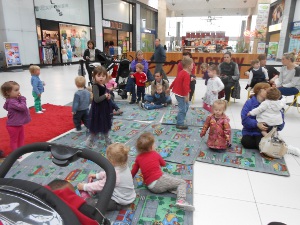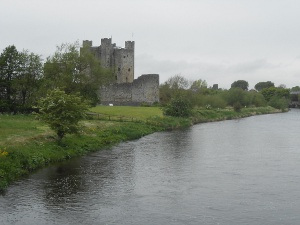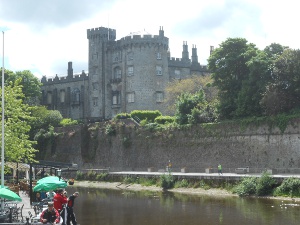 Victorian fountain, Dun Laoghaire
Victorian fountain, Dun Laoghaire
 Victorian fountain, Dun Laoghaire
Victorian fountain, Dun Laoghaire
We didn't have a car in Great Britain. In North America we sit in front of computers or books for too many hours a day, so this trip was designed to require us to walk more. But that did not mean we couldn't use the available public transportation. We bought two passes for the local Dublin buses and used them often. The bus drivers were often amused by our attempts to do sightseeing-by-bus, and made sure we knew where to catch a bus for the return trip.
Dun Laoghaire
One early trip was to the nearby town of Dun Laoghaire ("Dun Leary"), a seaside town about a half-hour from the center of Dublin.  Dun Laoghaire Carnegie library
Dun Laoghaire Carnegie library
This was a genealogy trip, where we found a lively family history group housed in an almost hidden office near the piers. We had a good walk along the main street, including a wander through an elegant Victorian hotel and views along the waterfront. We were surprised to spot a Carnegie Library -- later we found them in almost every city we visited. We returned to Dublin by train on the coast line which was recommended by a newspaper photographer we had met a few days previously -- it gave us great views of the ocean. Along the way, we viewed a range of neighborhoods from working class to gentry, as well as the entrances to a couple of tourist attractions.
 Toddlers at Charlestown Mall
Toddlers at Charlestown Mall
Charlestown
On another day, a museum we had planned to visit was closed, so we climbed on the first bus and rode it to the end of the line, where we found a small local shopping center. We arrived at the start of toddler playtime in the center of the mall and happily watched the children have fun.
Trim
Another genealogy trip took us to Trim and the genealogy society office for County Meath. The best part of that trip was the unexpected sight of Trim Castle. The town is famous for this 12th century Norman castle, built by Hugh de Lacy, which was used as the setting for the movie "Braveheart." Besides the
 Trim Castle on River Boyne
castle, we saw the stocks we think were used in the movie, the River Boyne, some well-maintained old houses in town, another ruin called the Yellow Steeple, and plenty of signs to explain things to us tourists.
Trim Castle on River Boyne
castle, we saw the stocks we think were used in the movie, the River Boyne, some well-maintained old houses in town, another ruin called the Yellow Steeple, and plenty of signs to explain things to us tourists.
We also saw many lush pastures. The surrounding land is primarily used for cattle and sheep raising, and so would have been less hard hit by the potato famine. It was a vivid lesson in the spottiness of the potato blight: some villages were almost destroyed by famine while other areas were basically untouched.
Wicklow Mountains
Ordinarily we don't take guided tours, but we wanted to see some mountains and we wanted to see some bog land and this sounded pretty good. Actually we did very well and the trip exceeded our expectations.
Heading south out of Dublin we took the freeway for a while, while the driver gave us some nice patter about Irish history. Then he turned off the freeway and almost immediately the road was narrow and curvy. It pretty much stayed that way throughout the day, except when it was very narrow and very curvy and he had to blow the horn a lot and scrape the bus against the nearby trees and hedgerows, or when it was extremely narrow and extremely curvy and he had to back up or have some huge delivery truck back up and drive up somebody's hilly driveway so we could get by or he had to have another bus driver give him signals to avoid crashing into the stone wall.
 In the Wicklow Mountains
In the Wicklow Mountains
All of which driving was pretty wonderful but not really frightening because our driver Richie knew what he was doing at the wheel of the bus, although he complained about its lack of power and a couple of times he talked to the other drivers just like Bob does.
The Wicklow Mountains are a National Park quite close to Dublin, about 700 meters high, which is high enough to be quite hilly and above tree level. After the last ice age Ireland was covered with one huge forest, until the trees got covered over with bog. We were fascinated because occasionally bog oak is uncovered, which has been preserved for thousands of years and makes really neat looking carvings. Once the bog gets established it acidifies the soil and only bog plants like sphagnum moss will grow there. It fills up at the rate of 1 millimeter a year so it takes quite a while to build three or four meters of bog. But the bog makes good fuel, which the Irish have known for a long time. It takes quite a lot of work to cut the peat into blocks and lay it out to dry for months and then finally bring a little home to burn at Christmas time.
We stopped for scones and tea at a Peace Center, which was the site of a special orphanage set up by the Irish after WW II to care for German war orphans, many of whom were adopted by the Irish. Today the center holds retreats and meetings to foster peace.
 Saint Kevin's Church
Saint Kevin's Church
Although Ireland has been inhabited for a long time there weren't any cities until 800 when the Vikings planted cities to use for trade and replenishment. Before that there were Irish kingdoms everywhere (up to 150 different kingdoms, arranged in a loosely hierarchical network determined by force of arms, but only once with a single high king - Brian Boru - on top). After St. Patrick these kingdoms all were Christianized, and all the kings sponsored monasteries, so Ireland was one of the most churchly countries in Europe.
We visited the ruins of St Kevin's Abbey, dating to before the Vikings. There were seven old churches, a round tower, a priests' house, graveyards, all near a running stream. Tourists had thrown coins in the stream and two wet-suited boys were scavenging the stream bed.
We stopped again for lunch at a pub and then once more at the Avoca woolen mill, a modern Irish success story. This old mill had stopped working and was about to be sold to an (evil) developer when the lawyer and his schoolteacher wife decided to give it a go, and Voila! today it employs 700 workers in 12 plants all over Ireland. It wasn't surprising to us that there's a good market for Irish woolens. They also do knitting at one of the plants, so we had to buy a sweater for her and a hat for him.
And then we rode back into Dublin while Richie played a collection of mostly modern Irish music CDs.
Kilkenny
Today dawned so sunny and welcoming that we dropped everything and climbed on a train to go to Kilkenny. This town, well-estabished by the Middle Ages, is a couple of hours from Dublin, far enough to let us have our train travel experience and close enough to make it a pleasant day trip.
 The castle in Kilkenny
The castle in Kilkenny
Dublin has several layers of transportation -- local and long-distance buses, a tram with both tracks and wire which bisects downtown, a light-rail system, and this national railroad. Bus travel probably is the most often selected means of getting from one place to another, but the railroad, which is still being expanded, is a pleasant way to see the countryside. The cars were new and clean and the ones we chose had wi-fi and electric outlets, plus tables between each two rows of seats.
We reached Kilkenny shortly before noon, after a couple of hours admiring the green, green hillsides and pastures and occasional tidy farmhouses, fields filled with cattle and sheep (there must be more lambs than people in Ireland right now).
The station is on a hill just at the edge of downtown. We walked through many blocks lined with houses which seem quite old but well maintained. Kilkenny is a shopping town -- there is a shopping center at the station, and the downtown stores sell all the expected items, from clothing to sporting goods to fruits and vegetables (the apples came from France which presumably is sunnier right now).
After checking out various cafes we selected Zuni where we had a delicious lunch. The proprietor told us that she had enjoyed eating at Zuni Cafe in San Francisco, liked the name and so took it back to Ireland with her. No other relationship to the Zuni culture was detected. But the food and service were excellent!
 Drogheda viaduct
Our shopping time was spent in an excellent book store, before we started on a meandering, sightseeing route back to the train station. We admired the outsides of the cathedral and the castle, both of which date back to before 1200 A.D. Part of the charm of this city, we think, is that it offers the very old and the up-to-date, and thus attracts such a nice variety of people.
Drogheda viaduct
Our shopping time was spent in an excellent book store, before we started on a meandering, sightseeing route back to the train station. We admired the outsides of the cathedral and the castle, both of which date back to before 1200 A.D. Part of the charm of this city, we think, is that it offers the very old and the up-to-date, and thus attracts such a nice variety of people.
Drogheda
Today, 3 Jun Tuesday after bank holiday, we took the train about an hour north of Dublin to Drogheda, which turned out to be the harbor town at the mouth of the Boyne River (remember the Battle of the Boyne?) with a number of old rebuilt ruins from various periods of antiquity from the Normans to the present.
We talked to the railroad guy about the beautiful RR viaduct across the Boyne, north of the station, after descending the steep flights of steps. We walked along the street bordering the river, passing a nest of white cats and kittens.
We stopped for tea and a scone, crossed the pedestrian bridge, and climbed the hill on the other side, following the noise to what we thought might have been a demonstration but was actually a performance, featuring a lot of unbeautiful women on noisy drums and one man, the director, who played some other instruments (?) and sang. Definitely loud.
We bought a shipping box and did not go to the church as they were having one of their three-times-daily masses, so we walked up another hill but found it quite uninteresting and when we came down we ran into ...
 Armed guards
the army standing around holding semi-automatic assault rifles; there were at least two cars of troops and one of armed gardai and then finally we saw the armored currency-carrying truck and talked to some locals and got the story that they were making a multiple-bank pickup after the long holiday weekend, and there was lots of money so therefore the extra armed escort...
Armed guards
the army standing around holding semi-automatic assault rifles; there were at least two cars of troops and one of armed gardai and then finally we saw the armored currency-carrying truck and talked to some locals and got the story that they were making a multiple-bank pickup after the long holiday weekend, and there was lots of money so therefore the extra armed escort...
We sure hope that nobody would try to steal any more or else that all those weapons were unloaded, because there were an awful lot of innocent bystanders milling around on a crowded shopping street. Nothing happened.
We inquired about returning to the train station and learned that there was a road up a gradual hill that got to the station without the necessity of negotiating the many stairs.
Between the green fields complete with sheep and cattle and crops, and the fascinating towns and villages, Ireland is definitely a tourist's delight.